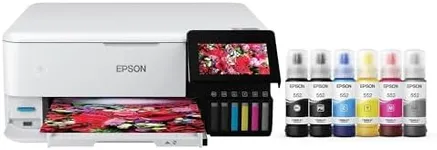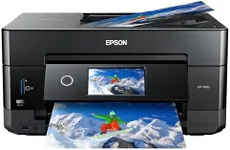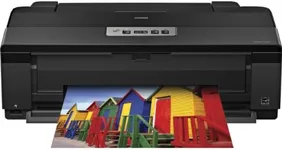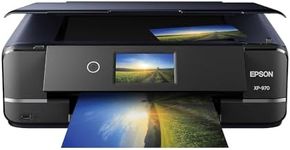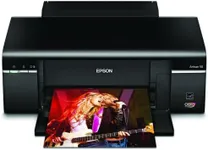Buying Guide for the Best Epson Photography Printers
Choosing the right Epson photography printer can make a significant difference in the quality of your printed photos. When selecting a printer, it's important to consider several key specifications that will impact the performance and output of your prints. Understanding these specs will help you make an informed decision and ensure that the printer you choose meets your specific needs as a photographer.Print ResolutionPrint resolution, measured in dots per inch (DPI), determines the level of detail and clarity in your printed photos. Higher DPI values mean more detailed and sharper images. For professional-quality photo prints, look for a printer with a resolution of at least 2400 DPI. If you are printing large photos or need extremely fine details, consider printers with even higher resolutions, such as 4800 DPI or more. For casual photo printing, a lower resolution may suffice, but higher resolutions are always better for capturing intricate details.
Ink SystemThe ink system in a printer affects color accuracy and the range of colors that can be reproduced. Epson photography printers often use multiple ink cartridges, including additional colors like light cyan and light magenta, to achieve more accurate and vibrant prints. Printers with more ink cartridges (such as 6 or 8) generally produce better color gradients and smoother transitions. If you are a professional photographer or require high-quality prints, opt for a printer with a more advanced ink system. For everyday photo printing, a standard 4-color ink system may be sufficient.
Print Size CapabilityPrint size capability refers to the maximum size of paper the printer can handle. If you plan to print large format photos, such as posters or gallery prints, you will need a printer that supports larger paper sizes, like A3 or larger. For standard photo prints, a printer that handles up to A4 size paper will be adequate. Consider your typical print sizes and choose a printer that can accommodate your needs. Larger print capabilities often come with higher costs and larger printer sizes, so balance your requirements with available space and budget.
Print SpeedPrint speed, measured in pages per minute (PPM), indicates how quickly a printer can produce prints. While speed is less critical for high-quality photo printing compared to document printing, it can still be a factor if you need to print large volumes of photos. Faster print speeds can save time, especially for professional photographers who need to deliver prints to clients quickly. For occasional photo printing, a slower speed may be acceptable. Evaluate your workflow and choose a printer with a speed that matches your productivity needs.
Connectivity OptionsConnectivity options determine how you can connect your devices to the printer. Common options include USB, Wi-Fi, and Ethernet. Wi-Fi connectivity allows for wireless printing from multiple devices, which is convenient for home or studio use. Some printers also support mobile printing via apps or cloud services, enabling you to print directly from your smartphone or tablet. If you prefer a wired connection for stability, ensure the printer has a USB or Ethernet port. Choose a printer with connectivity options that match your preferred workflow and device compatibility.
Paper HandlingPaper handling refers to the types and capacities of paper the printer can manage. Look for printers with multiple paper trays or feeders if you plan to use different types of paper, such as glossy, matte, or fine art paper. The ability to handle thicker media or specialty papers can be important for professional-quality prints. Additionally, consider the paper capacity if you need to print large batches of photos without frequent reloading. Choose a printer with paper handling features that align with your printing habits and the types of media you use.

